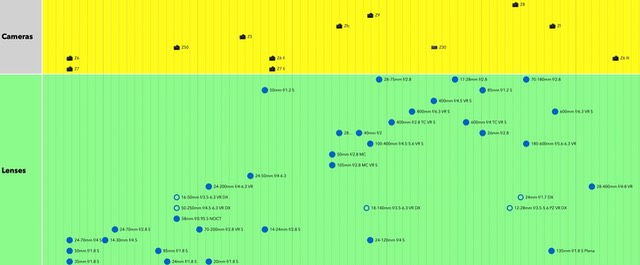A common question that comes up with cameras that iterate—as opposed to outright new models—is whether it was worth the wait as engineers worked at improving or adding things.
This is a particularly interesting question in the case of the Z6.

Try Open image in new tab in your browser if you can't read the individual items. Each vertical grid line is a month.
The initial Z6 was announced in August 2018, and shipped several months later. About two years later, in October 2020, Nikon introduced the Z6 II. The general consensus was that the Z6 II was a mild update that didn't add as much as Nikon suggested. Most of the discussion centered around autofocus performance and features, which many found to be a disappointing small step forward.
Looking back, I'd say that the Z6 II mostly represented a "tuning" of the Z6, nipping at a wide range of small things to create an improved version of this important camera. While I didn't say so specifically in my review, I never really considered the Z6 II a camera that Z6 users should update to. It was too little gain for the monetary hit of moving from the older model to the newer one.
Here we are not quite four years later and we have the next transition: Z6 II to Z6 III. Did a longer wait yield a camera you should update to?
We're six years into the Z6's history, so at this point you'd want to know that Nikon has fully considered what a camera at this price level should consist of, and how it should perform.
The good news is that it is easier to see the difference between a Z6 II and Z6 III. It's not surprising that Nikon's teaser said "ready to perform?" That's because most of the changes that have been made indeed center around performance. As a high speed camera, the Z6 III clearly is better than a Z6 II. As a video camera, the already near top-of-class performance of the original models has now made it to the very top. Focus finally has the full level of performance that DSLR users benefited from (and more). Had the Z6 III appeared in 2018, there would have been a stampede from DSLRs to mirrorless from the DX up through the D750 crowd. The addition of things like Pixel shift shooting just adds to the "goodness" of the Z6 III.
Unfortunately, the Z6 III doesn't live in a vacuum. No, I'm not talking about Canon R6 Mark II's and Sony A7 Mark IV's. Nikon users tend to stay Nikon users and while switching systems is a thing, it's not the bulk of sales, representing five to ten percent of a company's potential volume.
No, Nikon made their own competitor: the Zf. The Zf is less expensive than the Z6 III, but also has many of the same features and some of the same performance capabilities. You'll want to look at my comparison article to get the full sense, but it wouldn't be too far wrong to say that a Zf is 90+% of a Z6 III, only in a retro-clad body with few user control customization options instead of the modern DSLR-derived mirrorless form with better customization.
It's no secret that the Zf has been a very popular camera, perhaps more popular than Nikon originally expected it would be. With a proper hand grip attached, it's a very well-rounded camera that lets you control it in one of two ways: retro dials use, or modern button+dials use. The one clear downside to a Zf? No way to quickly restore a group of settings (via U# or banks).
I don't think it's a coincidence that the Zf came out nine months before the Z6 III. Nikon appeared to not only want to pick up those that value legacy design, but also some of the "where is the Z6 III" crowd that wanted an update. So you also now have to consider whether the Z6 III was worth the wait after the Zf.
In the end, I don't think it matters how long it took to get to the Z6 III. The truly serious user with plenty of disposable income already upgraded to the Z8. Another impatient group found that the Zf's use of the Z9-derived functions was enough for them. I believe the big challenge for the Z6 III is to pick up the lower level DSLR hangers-on, some of the original Z6 owners, and any new to the (Nikon) market users. To that end, the Z6 III appears to be a remarkably well-rounded camera, which is exactly what you'd expect given the time period over which it has evolved.
So now the question really turns to "where's the Z7 III?" And will it be worth the wait when it finally arrives?
